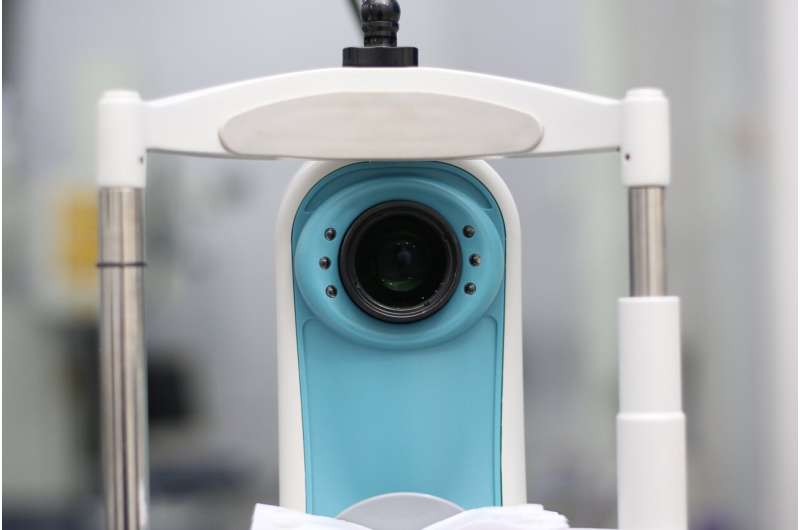AI-enabled imaging of retinas vascular network can predict cardiovascular disease and death

AI-enabled imaging of the retina’s network of veins and arteries can accurately predict cardiovascular disease and death, without the need for blood tests or blood pressure measurement, finds research published online in the British Journal of Ophthalmology.
As such, it paves the way for a highly effective, non-invasive screening test for people at medium to high risk of circulatory disease that doesn’t have to be done in a clinic, suggest the researchers.
Circulatory diseases, including cardiovascular disease, coronary heart disease, heart failure and stroke, are major causes of ill health and death worldwide, accounting for 1 in 4 UK deaths alone.
While several risk frameworks exist, these aren’t always able to accurately identify those who will go on to develop or die of circulatory diseases, say the researchers. Previously published research indicates that the width of the tiny veins and arteries (arterioles and venules) of the retina—the part of the eye that receives and organizes visual information—may provide an accurate early indicator of circulatory disease. But it’s not clear whether these findings apply consistently and equally to men and women.
So the researchers developed a fully automated artificial intelligence (AI)- enabled algorithm (QUantitative Analysis of Retinal vessels Topology and siZe, or QUARTZ for short) to develop models to assess the potential of retinal vasculature imaging plus known risk factors to predict vascular health and death.
They applied QUARTZ to retinal images from 88,052 UK Biobank participants aged 40-69, looking specifically at the width, vessel area, and degree of curviness (tortuosity) of the arterioles and venules in the retina to develop prediction models for stroke, heart attack, and death from circulatory disease.
They subsequently applied these models to the retinal images of 7411 participants, aged 48-92, of the European Prospective Investigation into Cancer (EPIC)-Norfolk study. The performance of QUARTZ was compared with the widely used Framingham Risk Scores framework, both separately and jointly.
The health of all the participants was tracked for an average of 7 to 9 years, during which time there were 327 circulatory disease deaths among 64,144 UK Biobank participants (average age 56) and 201 circulatory deaths among 5862 EPIC-Norfolk participants (average age 67).
In men, arteriolar and venular width, tortuosity, and width variation emerged as important predictors of death from circulatory disease. In women, arteriolar and venular area and width and venular tortuosity and width variation contributed to risk prediction.
The predictive impact of retinal vasculature on circulatory disease death interacted with smoking, drugs to treat high blood pressure, and previous heart attack. Overall, these predictive models, based on age, smoking, medical history and retinal vasculature, captured between half and two thirds of circulatory disease deaths in those most at risk.
Retinal vasculature models captured about 5% more cases of stroke in UK Biobank men and 8% more cases in UK Biobank women and 3% more cases among EPIC-Norfolk men most at risk, but nearly 2% fewer cases among EPIC-Norfolk women. Framingham Risk Scores captured more cases of heart attack among those most at risk.
Adding retinal vasculature to Framingham Risk Scores effected only marginal changes in the prediction of stroke or heart attack. But a simpler non-invasive risk score based on age, sex, smoking, medical history and retinal vasculature performed as well as the Framingham Risk Scores, and without the need for blood tests or blood pressure measurement, say the researchers.
They acknowledge that both groups of study participants have healthier lifestyles than other geographically similar middle-aged people, and that most are white. But this is the largest population-based study of retinal vasculature, and the prediction models were externally validated in a large number of people, they explain.
Retinal imaging is already common practice in the UK and the U.S., point out the researchers, who conclude, “AI-enabled vasculometry risk prediction is fully automated, low cost, non-invasive and has the potential for reaching a higher proportion of the population in the community because of ‘high street’ availability and because blood sampling or [blood pressure measurement] are not needed.”
They continue, “[Retinal vasculature] is a microvascular marker, hence offers better prediction for circulatory mortality and stroke compared with [heart attack] which is more macrovascular, except perhaps in women.
“In the general population it could be used as a non-contact form of systemic vascular health check, to triage those at medium-high risk of circulatory mortality for further clinical risk assessment and appropriate intervention.”
In the UK, for example, it could be included in the primary care NHS Health Check for those aged 41-74, they suggest.
In a linked editorial, Drs. Ify Mordi and Emanuele Trucco of the University of Dundee, Scotland, explain that the use of retinal vasculature changes to inform overall cardiovascular risk is “certainly attractive and intuitive,” but is yet to become part of routine clinical practice.
“Using retinal screening in this way would presumably require a significant increase in the number of ophthalmologists or otherwise trained assessors,” they suggest, and ask: Which specialty would take on responsibility for preventive treatment and the additional workload: ophthalmologists, cardiologists, or primary care practitioners?
Source: Read Full Article
